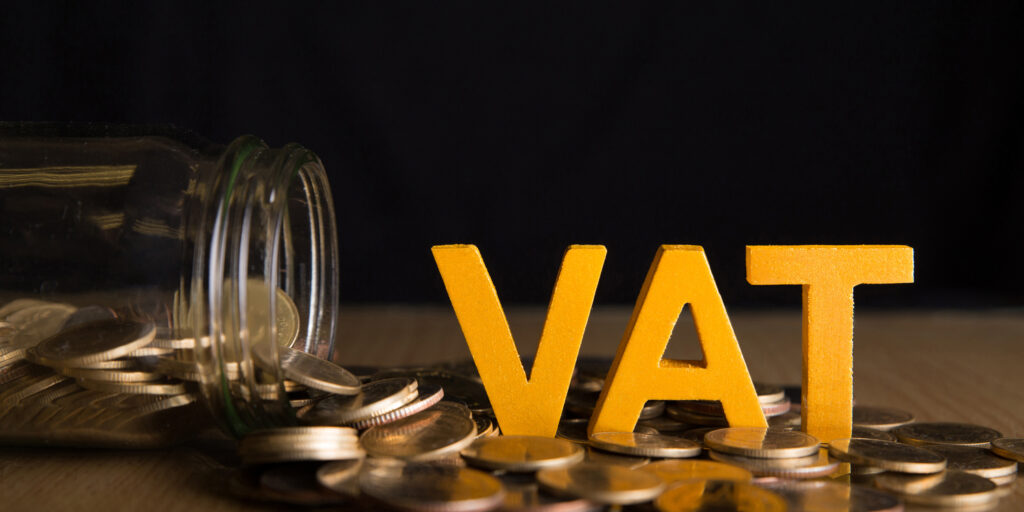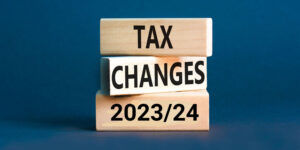When you register for VAT in the UK, HMRC will issue a VAT registration certificate. This will contain your unique VAT registration number, which identifies your business as a taxable person registered for VAT.
Your certificate will be posted to your registered office address (if you have a limited company or LLP) or business address (if you operate as a sole trader or business partnership).
This post explains the purpose of a VAT registration number, what it looks like, which businesses can apply for one, and the different situations when a VAT number may be required.
Key Takeaways
- A VAT registration number is a unique identifier issued to a business upon registering for VAT.
- UK VAT numbers contain a country code followed by nine digits.
- VAT-registered businesses must provide their VAT number on many occasions and include it on all invoices they raise.
What is a VAT registration number?
A VAT registration number (‘VRN’ or ‘VAT number’) is a unique identifier that HMRC issues to a business upon registering for UK VAT. Only VAT-registered businesses receive VRNs, so a valid number proves that a particular trader is VAT-registered.
HMRC and other businesses use VAT numbers to identify traders for all VAT-related purposes. If a business has a VAT number, it can charge VAT on the goods or services it sells and reclaim VAT on the goods or services it buys.
Traders must retain their VAT number until they cancel their registration or transfer the business as a going concern and the new owner wants to retain it.
What does a UK VAT number look like?
A UK VAT number usually contains nine digits prefixed by two letters. The prefix ‘GB’ is used for businesses in England, Scotland, and Wales. In Northern Ireland, the prefix ‘XI’ will be used instead if the business trades under the Northern Ireland Protocol.
For example, GB 123456789 or XI 123456789.
Other countries have different VAT number formats, but they typically feature an identifying country code followed by a block of numbers or characters. Some examples include:
- Denmark – country code ‘DK’ plus eight numbers, such as DK 12345678
- France – country code ‘FR’ plus 11 characters, such as FR 123456798910 or FR X1234567890
- Germany – country code ‘DE’ followed by nine numbers, such as DE 123456789
- Ireland – country code ‘EI’ followed by eight or nine characters, such as EI 1234567X or EI 1X23456X
HMRC provides more information on EU country codes and VAT numbers.
More than 170 countries have a VAT system, including the UK, all EU and EEA countries, Australia, Canada, China, India, Russia, and most countries in Latin America and the Caribbean.
There is no VAT system in the USA. Instead, businesses charge sales tax, which varies from state to state.
Do I need a VAT registration number?
You need to register for VAT and obtain a VAT registration number if you want to charge VAT on the things your business sells and/or reclaim VAT on business expenses. The rules are the same whether you’re a sole trader, partnership, or limited company.
Some businesses are legally required to register for VAT, whilst others can register voluntarily. You must register for VAT with HMRC if:
- Your total taxable turnover for the past 12 months exceeds £90,000 (the VAT threshold)
- You expect your taxable turnover to exceed £90,000 in the next 30 days
Your taxable turnover is the total value (excluding VAT) of your business sales.
VAT registration is also compulsory, regardless of taxable turnover, if all of the following apply:
- You are based outside the UK
- Your business is based outside the UK
- You supply goods or services to the UK (or expect to do so in the next 30 days)
In this situation, you are classed as a non-established taxable person (NETP). However, you may be able to apply for exemption from registration if all of your taxable goods or services are zero-rated (i.e. they have a 0% VAT rate).
Generally, you don’t need to register for VAT if everything you sell is VAT-exempt or ‘out of scope’ for VAT. Exceptions apply to certain businesses in Northern Ireland (see below).
Businesses in Northern Ireland
If your business is based in Northern Ireland, you need to register if both of the following apply:
- You only sell VAT-exempt or ‘out of scope’ goods and services
- You buy goods for more than £90,000 in any 12-month period from EU VAT-registered suppliers to use in your business
Voluntary VAT registration
Where VAT registration is not compulsory, you can still register for VAT voluntarily. This can be beneficial for many small businesses, enabling them to reclaim VAT on the goods or services they buy.
When will I use my VAT registration number?
If you register your business for VAT, you’ll use your VAT number on various occasions, including when you:
- Create a VAT online account with HMRC
- Enrol for any VAT accounting schemes
- Send a VAT Return to HMRC
- Pay your VAT bill
- Reclaim any VAT paid on goods and services bought for business use
- Issue VAT invoices and certain receipts to clients and customers
- Open a trading account on an online marketplace
- Set up accounts with certain suppliers
- Buy goods from VAT-registered suppliers
- Complete an EC sales list (Northern Ireland businesses only)
- Contact HMRC to discuss your VAT account
- Appoint an accountant or agent to deal with your tax affairs
If you purchase goods or services from VAT-registered suppliers in the EU, you should also provide your UK VAT number. Doing so will allow them to zero-rate the VAT charge on your order (apply a 0% VAT rate).
Do I need to display my VAT number on my website?
There’s no legal requirement to display your VAT number on your website. However, most VAT-registered businesses display it in the footer section.
Disclosing your VAT number on your website can enhance your credibility and help potential customers or clients make more informed choices.
If you sell through an online marketplace, the operator will also display your VAT number on their own website.
Where can I find my VAT number?
You can find your UK VAT number in various places, including:
- Your VAT online account
- On your VAT registration certificate
- On any previous VAT Return
- In letters from HMRC about your VAT registration
If you’re unable to locate it, you can call HMRC’s VAT general enquiries helpline on 0300 200 3700.
Do all businesses have a VAT number?
No, only VAT-registered businesses have a VAT number. While not all businesses need to register for VAT, all types and sizes of businesses can – even those with taxable turnover below the registration threshold. This means you can register whether you’re selling goods or services as a sole trader, partnership, limited company, or not-for-profit organisation.
You can’t register if you’re not in business. HMRC defines business as ‘a continuing activity carried on with the intention of making supplies for a consideration.’ In other words, providing goods or services in exchange for a form of payment. Non-business activities include pursuing hobbies and selling personal belongings.
Exemption from VAT registration
Some businesses can apply for VAT exemption, meaning they don’t have to register for VAT even if their turnover exceeds the threshold.
Your business may be exempt from registration if:
- Most of the taxable goods or services you sell are zero-rated (0% VAT rate)
- You’re a non-established taxable person making only zero-rated taxable supplies
You can apply to HMRC for exemption from VAT registration online or by post.
VAT registration ‘exception’
Under certain circumstances, you can apply for a VAT registration ‘exception’ if your taxable turnover exceeds the VAT threshold only temporarily. HMRC will require evidence showing why you believe your taxable turnover will remain below the VAT deregistration threshold of £88,000 over the next 12 months.
How to check a VAT registration number in the UK
HMRC provides an online service for checking UK VAT registration numbers. You can use this to:
- Check that a UK VAT registration number is valid
- Find out the name and address of the business to which the number is registered
- Prove when you checked a UK VAT number (this feature of the service is only available to UK VAT-registered businesses).
Alternatively, you can call HMRC’s VAT helpline on 0300 200 3700 (or +44 2920 501 261 if you’re outside the UK).
You cannot use this online service to find your own VAT number if you’ve recently applied to register and you’re still waiting to hear from HMRC. There’s a different service available for checking when you can expect a reply from HMRC about a recent application or query.
Checking an EU VAT number
If you need to check the VAT number of an EU-based business, you can use the European Commission’s VIES VAT number validation service.
How to get a VAT number in the UK
Most businesses register for VAT using HMRC’s online service. To do so, you’ll need to:
- Sign in to your HMRC business tax account with your Government Gateway user ID and password (or create a new user ID if you don’t already have an account)
- Select ‘Add a tax to your account to get online access to a tax, duty or scheme’
- Check the box for ‘VAT and VAT services’ then click ‘Continue’
- Select which VAT service you want to add
- Answer a series of questions about your business to establish why you are registering for VAT
- Provide information about yourself and your business (we outline the required information below)
- Follow the final steps on the online form to complete your application
Information required by sole traders and partnerships
If you’re registering for VAT as a self-employed sole trader or a partnership, you must provide the following details for HMRC:
- National Insurance number
- An identity document (e.g. a passport or driving licence)
- Bank account details
- Your Unique Taxpayer Reference (UTR), if you have one
- Details of your annual taxable turnover, including the date you exceeded (or expect to exceed) the VAT threshold, if applicable
If you’re registering a partnership for VAT, you’ll also need to complete form VAT2 with details of each partner and then upload it with your application.
Information required by limited companies
If you’re registering a company for VAT, you must provide the following details for HMRC:
- Company name
- Company registration number
- Date and country of incorporation
- The company’s Unique Taxpayer Reference
- Business contact details, including the registered office address or business address
- Details of annual taxable turnover, including the date you exceeded (or expect to exceed) the VAT threshold
- Description of business activities
- Business bank account details
- Information about Corporation Tax and (if applicable) Pay As You Earn (PAYE)
- Your name, address, date of birth, and National Insurance number
You should receive a VAT registration certificate from HMRC within approximately 30 working days. This will be sent to your company’s registered office address or business address.
If you’re unable to register online, you’ll need to register by post using the VAT1 paper form. Postal applications usually take longer to process.
1st Formations VAT Registration Service
At 1st Formations, we offer a VAT Registration Service for £39.99 +VAT. This is suitable for limited companies and limited liability partnerships (LLPs). You don’t need to have formed your company with us to use this service.
Whether registration is compulsory or voluntary, one of our VAT experts will prepare the necessary registration documents on your company’s behalf and submit them to HMRC online.
- A guide to commonly used VAT terms in the UK
- VAT registration for UK companies with non-resident directors
- Pros and cons of voluntary VAT registration
We can also assist with any questions you may have about your VAT registration, including guidance on how to set up your HMRC Government Gateway account.
As soon as your application has been approved, HMRC will post your VAT registration certificate and company VAT number to your registered office or business address.
Thanks for reading
We hope you’ve found this information helpful. Please comment below if you have any questions about his post, or contact us directly if you’d like to speak to someone about our VAT Registration Service.
Explore the 1st Formations Blog for more business advice, insights, and limited company guidance.
Please note that the information provided in this article is for general informational purposes only and does not constitute legal, tax, or professional advice. While our aim is that the content is accurate and up to date, it should not be relied upon as a substitute for tailored advice from qualified professionals. We strongly recommend that you seek independent legal and tax advice specific to your circumstances before acting on any information contained in this article. We accept no responsibility or liability for any loss or damage that may result from your reliance on the information provided in this article. Use of the information contained in this article is entirely at your own risk.












Join The Discussion
Comments (10)
Does a trading bulding company have to have a VAT number.?
Thank you for your comment, Eileen. Companies should register for VAT if they are expected to exceed £90,000 in the next 12 months or if they want to register voluntarily (to claim back VAT on goods and services or to give the appearance of a bigger/more established company). If you need or want to have your company registered for VAT, we can take care of the formalities and process the application on your behalf – https://www.1stformations.co.uk/vat-registration.
Kind regards,
The 1st Formations Team
Can a VAT registration be given to the owner of a business (ie as an individual name) when the name of the business is just a name and not registered as a company/ partnership or LLP. If that individual then charges VAT on the supply of 3rd party goods does the individual need to be transparent that the VAT charge is not the same as the trading name of a company?
I hope that makes sense.
Liz
Thank you for your kind comment.
Unfortunately as we are not regulated to provide accountancy advice, we are unable to provide advice on specific scenarios. We would recommend contacting a accountant for further assistance.
Please accept our apologies for any inconvenience caused.
Kind regards,
The 1st Formations Team
“As soon as you receive your VAT registration number, you have a legal obligation to display it on your business website”
Please can you confirm the law referred to above? Many thanks.
Thank you for your comment Jonathan. The legal obligation comes from the e-commerce regulations which state that this number must be easily, directly and permanently accessible. Adding the VAT number to the website meets this legal requirement and is the most common method of compliance.
Kind regards,
The 1st Formations Team
Your blog post about VAT was incredibly insightful and informative. I learned a lot about the different VAT rates and how they apply to various goods and services.
We’re glad you found this article of use, Ashikur.
Kind regards,
The 1st Formations Team
This is so helpful. Thank you!
We’re glad it was helpful!
Regards,
The 1st Formations Team